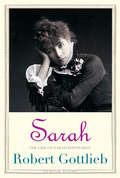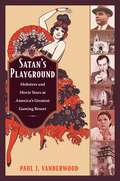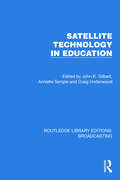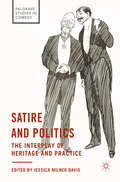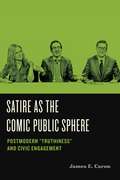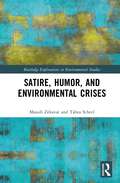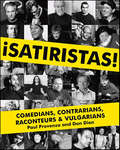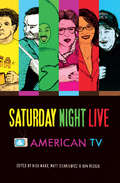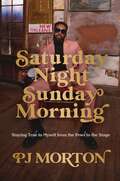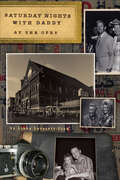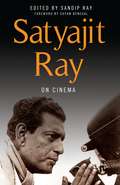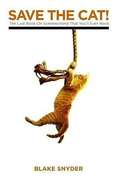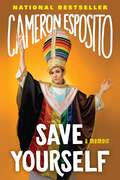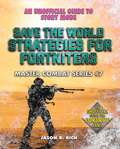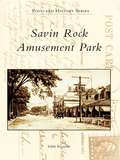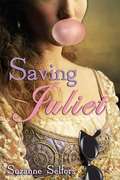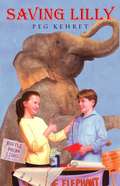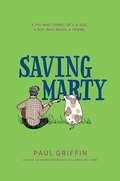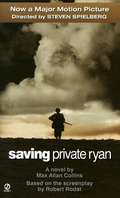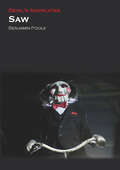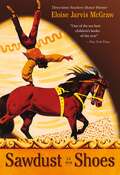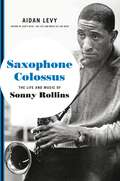- Table View
- List View
Sarah: The Life of Sarah Bernhardt
by Robert GottliebEverything about Sarah Bernhardt is fascinating, from her obscure birth to her glorious career--redefining the very nature of her art--to her amazing (and highly public) romantic life to her indomitable spirit. Well into her seventies, after the amputation of her leg, she was performing under bombardment for soldiers during World War I, as well as crisscrossing America on her ninth American tour. Her family was also a source of curiosity: the mother she adored and who scorned her; her two half-sisters, who died young after lives of dissipation; and most of all, her son, Maurice, whom she worshiped and raised as an aristocrat, in the style appropriate to his presumed father, the Belgian Prince de Ligne. Only once did they quarrel--over the Dreyfus Affair. Maurice was a right-wing snob; Sarah, always proud of her Jewish heritage, was a passionate Dreyfusard and Zolaist. Though the Bernhardt literature is vast, Gottlieb'sSarah is the first English-language biography to appear in decades. Brilliantly, it tracks the trajectory through which an illegitimate--and scandalous--daughter of a courtesan transformed herself into the most famous actress who ever lived, and into a national icon, a symbol of France.
Satan's Playground: Mobsters and Movie Stars at America's Greatest Gaming Resort
by Paul J. VanderwoodSatan's Playground chronicles the rise and fall of the tumultuous and lucrative gambling industry that developed just south of the U. S. -Mexico border in the early twentieth century. As prohibitions against liquor, horse racing, gambling, and prostitution swept the United States, the vice industry flourished in and around Tijuana, to the extent that reformers came to call the town "Satan's Playground," unintentionally increasing its licentious allure. The area was dominated by Agua Caliente, a large, elegant gaming resort opened by four entrepreneurial Border Barons (three Americans and one Mexican) in 1928. Diplomats, royalty, film stars, sports celebrities, politicians, patricians, and nouveau-riche capitalists flocked to Agua Caliente's luxurious complex of casinos, hotels, cabarets, and sports extravaganzas, and to its world-renowned thoroughbred racetrack. Clark Gable, Jean Harlow, Louis B. Mayer, the Marx Brothers, Bing Crosby, Charlie Chaplin, Gloria Swanson, and the boxer Jack Dempsey were among the regular visitors. So were mobsters such as Bugsy Siegel, who later cited Agua Caliente as his inspiration for building the first such resort on what became the Las Vegas Strip. Less than a year after Agua Caliente opened, gangsters held up its money-car in transit to a bank in San Diego, killing the courier and a guard and stealing the company money pouch. Paul J. Vanderwood weaves the story of this heist gone wrong, the search for the killers, and their sensational trial into the overall history of the often-chaotic development of Agua Caliente, Tijuana, and Southern California. Drawing on newspaper accounts, police files, court records, personal memoirs, oral histories, and "true detective" magazines, he presents a fascinating portrait of vice and society in the Jazz Age, and he makes a significant contribution to the history of the U. S. -Mexico border.
Satellite Technology in Education (Routledge Library Editions: Broadcasting #31)
by John K. Gilbert Annette Temple Craig UnderwoodSatellite Technology in Education (1991) provides a coherent introduction to the potential of satellite technology in education. It begins with a brief technical history of some of the different systems, making distinctions between remote sensing, telecommunications and amateur radio satellites. It then examines the uses of satellite technology in the teaching of geography and environmental studies, languages, science and information technology. The book goes on to look at the response of different sectors, including schools and teacher education and higher education establishments, and concludes with a discussion of legal issues and an analysis of the resources needed to realize the impact of satellites on education.
Satire & The State: Sketch Comedy and the Presidency
by Matt FotisSatire & The State focuses on performance-based satire, most often seen in sketch comedy, from 1960 to the present, and explores how sketch comedy has shaped the way Americans view the president and themselves. Numerous sketch comedy portrayals of presidents that have seeped into the American consciousness – Chevy Chase’s Gerald Ford, Dana Carvey’s George H.W. Bush, and Will Ferrell’s George W. Bush all worked to shape the actual politician’s public persona. The book analyzes these sketches and many others, illustrating how comedy is at the heart of the health and function of American democracy. At its best, satire aimed at the presidency can work as a populist check on executive power, becoming one of the most important weapons for everyday Americans against tyranny and political corruption. At its worst, satire can reflect and promote racism, misogyny, and homophobia in America. Written for students of Theatre, Performance, Political Science, and Media Studies courses, as well as readers with an interest in political comedy, Satire & The State offers a deeper understanding of the relationship between comedy and the presidency, and the ways in which satire becomes a window into the culture, principles, and beliefs of a country.
Satire TV: Politics and Comedy in the Post-Network Era
by Jonathan Gray Jeffrey P. Jones Ethan ThompsonA fascinating look into what happens when comedy becomes political and politics becomes comedySatirical TV has become mandatory viewing for citizens wishing to make sense of the bizarre contemporary state of political life. Shifts in industry economics and audience tastes have re-made television comedy, once considered a wasteland of escapist humor, into what is arguably the most popular source of political critique. From fake news and pundit shows to animated sitcoms and mash-up videos, satire has become an important avenue for processing politics in informative and entertaining ways, and satire TV is now its own thriving, viable television genre.Satire TV examines what happens when comedy becomes political, and politics become funny. A series of original essays focus on a range of programs, from The Daily Show to South Park, Da Ali G Show to The Colbert Report, The Boondocks to Saturday Night Live, Lil’ Bush to Chappelle’s Show, along with Internet D.I.Y. satire and essays on British and Canadian satire. They all offer insights into what today’s class of satire tells us about the current state of politics, of television, of citizenship, all the while suggesting what satire adds to the political realm that news and documentaries cannot.
Satire and Politics: The Interplay of Heritage and Practice (Palgrave Studies in Comedy)
by Jessica Milner DavisThis book examines the multi-media explosion of contemporary political satire. Rooted in 18th century Augustan practice, satire's indelible link with politics underlies today's universal disgust with the ways of elected politicians. This study interrogates the impact of British and American satirical media on political life, with a special focus on political cartoons and the levelling humour of Australasian satirists.
Satire as the Comic Public Sphere: Postmodern “Truthiness” and Civic Engagement (Humor in America #2)
by James E. CaronStephen Colbert, Samantha Bee, John Oliver, and Jimmy Kimmel—these comedians are household names whose satirical takes on politics, the news, and current events receive some of the highest ratings on television. In this book, James E. Caron examines these and other satirists through the lenses of humor studies, cultural theory, and rhetorical and social philosophy, arriving at a new definition of the comic art form. Tracing the history of modern satire from its roots in the Enlightenment values of rational debate, evidence, facts, accountability, and transparency, Caron identifies a new genre: "truthiness satire." He shows how satirists such as Colbert, Bee, Oliver, and Kimmel—along with writers like Charles Pierce and Jack Shafer—rely on shared values and on the postmodern aesthetics of irony and affect to foster engagement within the comic public sphere that satire creates. Using case studies of bits, parodies, and routines, Caron reveals a remarkable process: when evidence-based news reporting collides with a discursive space asserting alternative facts, the satiric laughter that erupts can move the audience toward reflection and possibly even action as the body politic in the public sphere.With rigor, humor, and insight, Caron shows that truthiness satire pushes back against fake news and biased reporting and that the satirist today is at heart a citizen, albeit a seemingly silly one. This book will appeal to anyone interested in and concerned about public discourse in the current era, especially researchers in media studies, communication studies, political science, and literary and cultural studies.
Satire as the Comic Public Sphere: Postmodern “Truthiness” and Civic Engagement (Humor in America)
by James E. CaronStephen Colbert, Samantha Bee, John Oliver, and Jimmy Kimmel—these comedians are household names whose satirical takes on politics, the news, and current events receive some of the highest ratings on television. In this book, James E. Caron examines these and other satirists through the lenses of humor studies, cultural theory, and rhetorical and social philosophy, arriving at a new definition of the comic art form. Tracing the history of modern satire from its roots in the Enlightenment values of rational debate, evidence, facts, accountability, and transparency, Caron identifies a new genre: “truthiness satire.” He shows how satirists such as Colbert, Bee, Oliver, and Kimmel—along with writers like Charles Pierce and Jack Shafer—rely on shared values and on the postmodern aesthetics of irony and affect to foster engagement within the comic public sphere that satire creates. Using case studies of bits, parodies, and routines, Caron reveals a remarkable process: when evidence-based news reporting collides with a discursive space asserting alternative facts, the satiric laughter that erupts can move the audience toward reflection and possibly even action as the body politic in the public sphere.With rigor, humor, and insight, Caron shows that truthiness satire pushes back against fake news and biased reporting and that the satirist today is at heart a citizen, albeit a seemingly silly one. This book will appeal to anyone interested in and concerned about public discourse in the current era, especially researchers in media studies, communication studies, political science, and literary and cultural studies.
Satire, Humor, and Environmental Crises (Routledge Explorations in Environmental Studies)
by Tabea Scheel Massih ZekavatSatire, Humor, and Environmental Crises explores how satire and humor can be employed to address and mitigate ecological crises at individual and collective levels. Besides scientific and technological endeavors, solutions to ecological crises must entail social and communicative reform to persuade citizens, corporations, organizations, and policymakers to adopt more sustainable lifestyles and policies. This monograph reassesses environmental behavior and messaging and explores the promises of humorous and satiric communication therein. It draws upon a solid and interdisciplinary theoretical foundation to explicate the individual, social, and ecospheric determinants of behavior. Creative works of popular culture across various modes of expression, including The Simpsons, Last Week Tonight with John Oliver, and The New Yorker cartoons, are examined to illustrate the strong if underappreciated relationship between humor and the environment. This is followed by a discussion of the instruments and methodological subtleties involved in measuring the impacts of humor and satire in environmental advocacy for the purpose of conducting empirical research. More broadly, the book aspires to participate in urgent cultural and political discussions about how we can evaluate and intervene in the full diversity of environmental crises, engage a broad set of internal and external partners and stakeholders, and develop models for positive social and environmental transformations. This book will be of great interest to students and scholars interested in environmental humanities, communication science, psychology, and critical humor studies. It can further benefit environmental activists, policymakers, NGOs, and campaign organizers.
Satiristas: Comedians, Contrarians, Raconteurs & Vulgarians
by Paul Provenza Dan DionFeaturing our greatest comedic minds on the nature of humor, its relevance in society—and why sometimes you just need a good dirty joke to cleanse the palate—Satiristas is a hilarious multi-voiced manifesto on satire and comedy presented by Paul Provenza, co-creator of The Aristocrats.
Saturday Night Live & American TV
by Nick Marx, Matt Sienkiewicz, Ron BeckerThought-provoking and &“undeniably interesting&” essays on this cultural institution of comedy and what it says about our society (Booklist). Since 1975, &“Live from New York, it&’s Saturday Night!&” has greeted late night–TV viewers looking for the best in sketch comedy and popular music. SNL is the variety show that launched the careers of countless comedians, including Dan Aykroyd, Chevy Chase, Chris Farley, Will Ferrell, Tina Fey, Amy Poehler, and Adam Sandler. Week after week, SNL has produced everything from unforgettable parodies to provocative political satire—adapting to changing times decade after decade while staying true to its original vision of performing timely topical humor. With essays that address issues ranging from race and gender to authorship and comedic performance, Saturday Night Live and American TV follows the history of this iconic show, and its place in the shifting social and media landscape of American television.
Saturday Night, Sunday Morning: Staying True to Myself from the Pews to the Stage
by PJ MortonGrammy-winning singer-songwriter, keyboardist for the mega pop band Maroon 5, and founder of Morton Records, PJ Morton details the inspiring journey that led to his unique sound and urges readers to follow their own dreams. The son of pastors and gospel artists, PJ Morton grew up singing gospel music in church. As he was drawn to R&B and pop, PJ experimented in combining genres to create his own sound that record labels struggled to categorize. Despite the pressure to conform, he defied expectations and risked launching his own label, Morton Records, leading to twenty Grammy nominations and awards. PJ Morton is the rare artist who has straddled the tensions of life, whether in music or faith expressions, or in racial and cultural identities, while staying true to his New Orleans and Christian roots. Saturday Night, Sunday Morning captures his powerful journey of combining his two worlds, showing readers how to overcome obstacles as they seek their own dreams.
Saturday Nights with Daddy at the Opry
by Libby Leverett-CrewThe daughter of the Grand Ole Opry’s official photographer reminisces about witnessing country music history alongside her father in this memoir.Like many little girls, Libby Leverett-Crew’s father, Les Leverett, often had to work nights and weekends. But unlike many girls, Libby’s father took her along to his job—where he was the official photographer for the Grand Ole Opry for more than thirty years.First at the historic Ryman Auditorium, and later at the Grand Ole Opry House, Libby Leverett-Crew was a witness to country music history. And now some forty years later, she pays tribute to the wonderful people who touched the lives of her entire family while at the same time hearing witness to the powerful impact a loving father can have on his child’s life.In Saturday Nights with Daddy at the Opry, Libby Leverett-Crew shares not only her remarkable memories of those Saturday nights with Dolly Parton, Minnie Pearl, Roy Acuff, Bill Monroe, and countless others, including assorted Muppets, astronauts, ballet dancers, actors, Andy Warhol, and k.d. lang, but also a beautiful father-daughter relationship. The book also includes more than 100 photographs from her father.Praise for Saturday Nights with Daddy at the Opry“Les Leverett has added so much class and talent to our world; I’m not surprised that his daughter, Libby, has done this book. Yeah, Libby good for you. I’m proud to have baby-sat you from time to time backstage. You were always a joy.” —Dolly Parton“There’s an old song, “I Was There When It Happened So I Guess I Oughta Know.” That’s [Libby’s] story inside the world of country music. I knew her first as Les Leverett’s kid. It must be in the water at their house because she’s come into her own as a masterful photographer. She also wields a pen that has a detailed memory for great storytelling.” —Marty Stuart
Satyajit Ray on Cinema
by Satyajit RaySatyajit Ray, one of the greatest auteurs of twentieth century cinema, was a Bengali motion-picture director, writer, and illustrator who set a new standard for Indian cinema with his Apu Trilogy: Pather Panchali (Song of the Little Road) (1955), Aparajito (The Unvanquished) (1956), and Apur Sansar (The World of Apu) (1959). His work was admired for its humanism, versatility, attention to detail, and skilled use of music. He was also widely praised for his critical and intellectual writings, which mirror his filmmaking in their precision and wide-ranging grasp of history, culture, and aesthetics. Spanning forty years of Ray's career, these essays, for the first time collected in one volume, present the filmmaker's reflections on the art and craft of the cinematic medium and include his thoughts on sentimentalism, mass culture, silent films, the influence of the French New Wave, and the experience of being a successful director. Ray speaks on the difficulty of adapting literary works to screen, the nature of the modern film festival, and the phenomenal contributions of Jean-Luc Godard and the Indian actor, director, producer, and singer Uttam Kumar. The collection also features an excerpt from Ray's diaries and reproduces his sketches of famous film personalities, such as Sergei Eisenstein, Charlie Chaplin, and Akira Kurosawa, in addition to film posters, photographs by and of the artist, film stills, and a filmography. Altogether, the volume relays the full extent of Ray's engagement with film and offers extensive access to the thought of one of the twentieth-century's leading Indian intellectuals.
Save The Cat!: The Last Book on Screenwriting You'll Ever Need
by Blake SnyderThis fun-to-read insiders guide reveals the truth about what it takes to craft and sell a script. After a lucrative 20-year career that includes working with some of the top producers in Hollywood, Snyder opens up his notebooks and shows how he creates, develops, beats out and writes a screenplay that accommodates the business practices of the script buyers.
Save Yourself: Essays
by Cameron EspositoFrom rising comedy star Cameron Esposito, a memoir that is "as hilarious and honest as she is on the stage," tackling the big issues explored in her comedy, including gender, sexuality and feminism - and how her Catholic childhood prepared her for a career as an outspoken lesbian comedian in ways the Pope could never have imagined (Abby Wambach).Cameron Esposito wanted to be a priest and ended up a stand-up comic. Now she would like to tell the whole queer as hell story. Her story. Not the sidebar to a straight person's rebirth-she doesn't give a makeover or plan a wedding or get a couple back together. This isn't a queer tragedy. She doesn't die at the end of this book, having finally decided to kiss the girl. It's the sexy, honest, bumpy, and triumphant dyke's tale her younger, wasn't-allowed-to-watch-Ellen self needed to read. Because there was a long time when she thought she wouldn't make it. Not as a comic, but as a human. SAVE YOURSELF is full of funny and insightful recollections about everything from coming out (at a Catholic college where sexual orientation wasn't in the nondiscrimination policy) to how joining the circus can help you become a better comic (so much nudity) to accepting yourself for who you are-even if you're, say, a bowl cut-sporting, bespectacled, gender-nonconforming child with an eye patch (which Cameron was). Packed with heart, humor, and cringeworthy stories anyone who has gone through puberty, fallen in love, started a career, or had period sex in Rome can relate to, Cameron's memoir is for that timid, fenced-in kid in all of us-and the fearless stand-up yearning to break free.
Save the World Strategies for Fortniters: An Unofficial Guide to Story Mode (Master Combat #7)
by Jason RichComplete the hardest missions, defeat your enemies, and save the world with this all-new, all-encompassing guide book! Fortnite: Save the World is the #1 cooperative player-versus-environment gaming adventure out there. Building on the combat and survival skills of Fortnite: Battle Royale, Save the World offers a uniquely challenging experience. Using the valuable tips in this illustrated, information-packed guide, you&’ll be better equipped to: Catapult your four-person team to victory by completing even the toughest missionsAvoid the catastrophic storm and battle the zombies that are bent on destroying you. Build weapons and structures, explore, gather resources, and manage your inventory like a pro Whether you play Fortnite: Battle Royale on a PC, Mac, Xbox One, PlayStation 4, Nintendo Switch, or your mobile device, inside you&’ll find the essential tips and secrets you need to snag more victories and achieve your objectives. This illustrated, easy-to-use guide gives you the rundown of all things Save the World so you can play like a pro. Save the World Strategies for Fortniters provides the ultimate, unofficial, competitive advantage for new and experienced gamers alike.
Savin Rock Amusement Park (Postcard History Series)
by Edith ReynoldsSavin Rock Amusement Park began to grow in the 1870s when George Kelsey constructed a pier to extend ferry service between the opposite coastlines of New Haven Harbor. This opened the door for further, more sophisticateddevelopment of amusement attractions that drew fun seeking patrons from throughout southern New England. The park thrived until the combination of affordable personal transportation and urban redevelopment forced its demise in the 1960s. Today Savin Rock is a quieter spot fi lled with beachside apartments, a shopping plaza, and a more tranquil grassy park jutting into the harbor. Only a few of the original restaurants remain, changed somewhat from their earlier days but still holding tight to the memories of a different time. Savin Rock Amusement Park contains postcards from the private collection of Ronald P. Guerrera. As an antiques dealer in Waterbury, Guerrera compiled one of the largest and most picturesque collections of postcard memorabilia in Connecticut.
Saving Juliet
by Suzanne SelforsMimi Wallingford, Great Granddaughter of Adelaide Wallingford, has the life that most girls dream about, playing Juliet opposite teen heartthrob Troy Summer on Broadway in Shakespeare's famous play. Unfortunately, she has no desire to be an actress, a fact her mother can't seem to grasp. But when she and Troy are magically thrust into Shakespeare's Verona, they experience the feud between the Capulets and Montagues first hand. Mimi realizes that she and Juliet have more in common than Shakespeare's script -- they are both fighting for futures of their own choosing. Mimi feels compelled to help her and with Troy's unexpected help, hopes to give Shakespeare's most famous tragedy a happily-ever-after ending.
Saving Lilly
by Peg KehretErin Wrenn and her friend David are in trouble as they refuse to go on a field trip to the Glitter Tent Circus. They wrote a report on the sad lives of circus animals, and find that the Glitter Tent Circus is one of the worst animal abusers of all.
Saving Marty
by Paul GriffinFans of Because of Winn Dixie will adore this warm and heart-wrenching story of the friendship between a boy and a pig who thinks it's a dog. <P><P>Eleven-year-old Lorenzo Ventura knows heroes are rare—like his father, who died in the war, or his friend Paloma Lee, who fearlessly pursues her dream of being a famous musician. Renzo would never describe himself as a hero, but his chance comes when he adopts Marty, a runt piglet. <P><P>Marty is extraordinary—he thinks he’s a dog and acts like one too—and his bond with Renzo is truly one of a kind. At first, the family farm seems like the perfect home for Marty, but as he approaches 350 pounds, it becomes harder for Renzo to convince his mom that a giant pig makes a good pet. <P><P>So when Marty causes a dangerous (and expensive) accident, Renzo knows Marty’s time is up. He’d do anything and everything for his best friend, but will everything be enough to save Marty? <P><P>Paul Griffin masterfully melds the heartrending and the hopeful in this unforgettable story about the power of friendship . . . and the unsung heroes all around us.
Saving Private Ryan
by Max Allan Collins Robert RodatJune 6, 1944. Military forces converge on the beaches of Normandy for one of the most decisive battles of World War II. America would call it a victory. History would call it D-Day. But for Captain John Miler and his squad of young soldiers, this fateful day would become something much more. Washington has sent them on a personal mission to save one life. One paratrooper missing in action. One soldier who has already lost three brothers in the war. Captain Miller and his men quickly realize this is not a simple rescue operation. It is a test of their honor and their duty. Their sole obsession - and their last hope for redemption. In a war of devastating proportions, saving one life could make all the difference in the world?
Saw
by Ben PooleLike all game changers within the horror genre, SAW was an independent success, a low-budget champion that flourished without the patronage of a big studio. Not bad for the most successful horror franchise ever, which has spawned subsidiary media and masses of merchandise, including a theme park rollercoaster ride. What is it about SAW that attracted such a following? In his contribution to the "Devil's Advocates" series, Ben Poole considers the SAW phenomenon from all aspects of film and media studies - from its generic pedigree in both literature and film, to the visceral audience pleasures ("what would I do?") of the text, to the contrasting representations of men and women and the film's implicit criticism of masculinity.
Sawdust in His Shoes
by Eloise Jarvis McGrawAn outsider becomes a hero and a boy becomes a man in this classic coming-of-age tale from the heyday of the three-ring circus, by three-time Newbery Honor Book author Eloise Jarvis McGraw. The circus is all young Joe Lang knows. The third generation of a circus family, he becomes a star bareback rider by the time he turns fifteen. But when his father, a lion-tamer, is killed by one of his cats, Joe becomes an orphan and is sent away to a vocational school while the law decides whether or not Mo Shapely, an old clown, is a fit guardian for him. Meanwhile, the circus moves on. Joe escapes from the school and stumbles into the farm life of the Dawson family, who take him in. Mistrustful at first, Joe grows to love farming and his foster family. Faced with prejudice as an outsider in a closely-knit rural community, he closely guards the secret of his past--until the day his extraordinary acrobatic talent is called for to save a life. Joe earns respect, but there is still circus is in his blood, sawdust in his shoes. Will he ever be happy away from his former life with the greatest show on earth?
Saxophone Colossus: The Life and Music of Sonny Rollins
by Aidan Levy**Winner of the American Book Award (2023)** **Longlisted for the PEN/Jacqueline Bograd Weld Award (2023)** The long-awaited first full biography of legendary jazz saxophonist and composer Sonny Rollins Sonny Rollins has long been considered an enigma. Known as the &“Saxophone Colossus,&” he is widely acknowledged as one of the greatest jazz improvisers of all time, winning Grammys, the Austrian Cross of Honor, Sweden&’s Polar Music Prize and a National Medal of Arts. A bridge from bebop to the avant-garde, he is a lasting link to the golden age of jazz, pictured in the iconic &“Great Day in Harlem&” portrait. His seven-decade career has been well documented, but the backstage life of the man once called &“the only jazz recluse&” has gone largely untold—until now. Based on more than 200 interviews with Rollins himself, family members, friends, and collaborators, as well as Rollins&’ extensive personal archive, Saxophone Colossus is the comprehensive portrait of this legendary saxophonist and composer, civil rights activist and environmentalist. A child of the Harlem Renaissance, Rollins&’ precocious talent landed him on the bandstand and in the recording studio with Bud Powell, Thelonious Monk, Charlie Parker, Miles Davis and Dizzy Gillespie, or playing opposite Billie Holiday. An icon in his own right, he recorded Tenor Madness, featuring John Coltrane; Way Out West; Freedom Suite, the first civil rights-themed album of the hard bop era; A Night at the Village Vanguard; and the 1956 classic Saxophone Colossus. Yet his meteoric rise to fame was not without its challenges. He served two sentences on Rikers Island and won his battle with heroin addiction. In 1959, Rollins took a two-year sabbatical from recording and performing, practicing up to 16 hours a day on the Williamsburg Bridge. In 1968, he left again to study at an ashram in India. He returned to performing from 1971 until his retirement in 2012. The story of Sonny Rollins—innovative, unpredictable, larger than life—is the story of jazz itself, and Sonny&’s own narrative is as timeless and timely as the art form he represents. Part jazz oral history told in the musicians&’ own words, part chronicle of one man&’s quest for social justice and spiritual enlightenment, this is the definitive biography of one of the most enduring and influential artists in jazz and American history.
